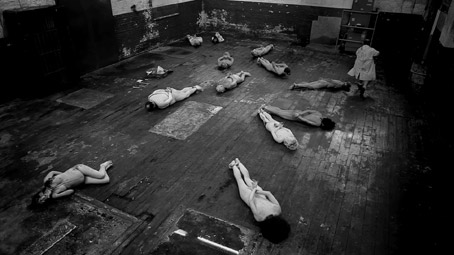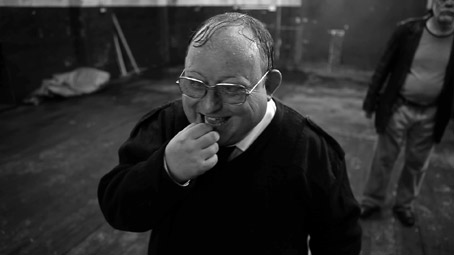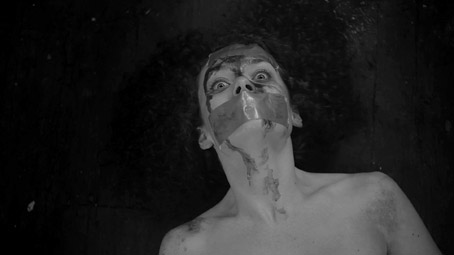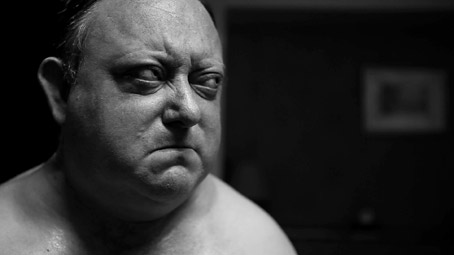|
A few years ago, a friend of mine who taught film production gave me a document that he handed to new students at the start of each academic year. It was a list of what he and his colleagues regarded as typical student films and film characteristics, and was designed to act as a warning of things that the lecturers had seen far too much of and didn't want to watch again. Turn in a film that fell foul of this list and you could expect to suffer the wrath of Khan. One of my favourites was the intriguingly titled 'Margate Taxi Driver'. Films in this category always had the same basic setup. A lone male, usually of student age (no kidding), became so obsessed with his favourite film that he started acting like its lead character. It was never set in an approximation of America, but whatever London borough or seaside town the university was located in or the student who made the damned thing lived. Taxi Driver, it turned out, was a choice pick back in the late 1970s. Later favourites included Reservoir Dogs and The Blair Witch Project. You haven't lived until you've seen a bunch of underfed film students trying to look tough by wearing sunglasses and waving plastic guns, or standing in front of a bathroom mirror asking their reflection if it's talking to me. These were not films, but fan boy cine-wanks, feeble attempts to look talented by poorly emulating the cinematic glory of their betters.
With that in mind, consider the following plot summary of The Human Centipede 2 [Full Sequence]. Martin is an uncommunicative car park attendant with an obsession for the first Human Centipede film. He repeatedly watches it on his laptop at work and keeps a scrapbook of photos and artwork relating to it under his mattress at home. Inspired by the movie, he secures an empty warehouse and begins kidnapping people who wander into his underground car park, his intention being to construct his own human centipede, one consisting of twelve people rather than the film's paltry three. Ah...

Regular readers will be aware that I have no bug up my arse about violent or even morally dubious film content. Actually, I'm rather fond of it. I was also a bit of a fan of The Human Centipede [First Sequence]. In spite of its censor-baiting content, there was just too much going on beneath its disturbing surface for it not to be seen as an allegorical work. And given that Tom Six was the director of both films, he can hardly be accused of playing the wannabe imitation game with part 2. So what, exactly, is going on here?
Rather than just banging out a sequel, Six clearly wanted to create a second film that was significantly different to the first. Full marks for that. And different it is, both in appearance (it's in black and white) and location (we're in London!). And while the concept is essentially the same – unhinged obsessive kidnaps people to stick together to create the human centipede of the title – there's a world of difference in the medical skills of the protagonists. Dr. Heiter, after all, was a surgeon with medical instruments and a private operating theatre, while Martin is a parking attendant with a grubby warehouse and the sort of tools you would usually find under the kitchen sink in an oily bag. We thus know from an early stage that this is going to be a messier experience than its predecessor, and few would classify that as an easy watch.
Kidnapping and inflicting violence on victims is the stuff of tawdry torture porn, but First Sequence was always much more than that. Sure, it was sometimes tough going, but nestled beneath the horror was a smartly made and savvy meditation on power and communication, one in which our sympathies were always with the victims of Dr. Heiter's ghastly experiment. Not this time, matey. Here the victims have one purpose only, to provide twisted entertainment and perverse sexual excitement for Martin and, by association, an audience in search of ever more darkly extreme cinematic thrills. The character introductions are too brief to allow any audience connection, and those we do spend more than a few seconds with are blokey tossers who scowl angrily and bark things like "What are you FUCKING looking at?" in a voice that makes them sound like they're auditioning for roles in a low-budget mockney gangster flick. In the mode of those annoying American teens that slasher fans once paid to see slaughtered, we are encouraged to enjoy seeing these monkeys get their comeuppance. In this respect, there's a suspicion that the pregnant woman and the nice interracial couple have been thrown in by Six to remind us that he's being controversial, and to prevent us getting too comfortable with the violence being dished out.
Martin, on the other hand, is given enough screen time and background detail to suggest that we're supposed to bond with him instead. As played by Laurence Harvey, he's every bit as memorable a screen character as the theatrical Dr. Heiter, but is also a composite of a just about every dangerous weirdo cliché you care to name. He's short, fat, ugly, uncommunicative, obsessive, lives with his angry mother, was abused by his father, is the object of lust for the family doctor, walks around in his underpants, regularly shits himself, and masturbates with sandpaper. On top of that he's an asthmatic, which in horror films means only one thing, that at a crucial point in the story he'll be unable to do something because he's wheezing and can't find or reach his inhaler. Oh yes, he's also mentally handicapped. I'll be coming back to that one.

But for all that, there are early indications that this perspective and style switch might actually pay off. Martin's mother may play her frustrations to the gallery, but the sheer oddness of Martin's home life, coupled with David Meadows' steely monochrome cinematography and James Edward Barker's deeply unsettling, semi-abstract score, give scenes set there an unexpected Eraserhead quality, and that's not a parallel I draw lightly. But once Martin has his twelve victims and starts laying out tools on the warehouse floor, its all about the spectacle of watching him inflict violence on wiggling, screaming, gaffer-taped slabs of meat. And violent it is, despite two-and-a-half minutes of BBFC enforced cuts. Stripping the film of colour in some ways accentuates the horror – it blackens the blood, gives the prosthetics some room to breathe, and really brings home the do-it-yourself crudeness of Martin's approach. The cuts may have lessened the impact of the forced coprophagia, and there is no indication left that Martin wraps his penis in barbed wire before raping his abominable creation, or that a woman attempting escape accidentally kills her new born baby by stamping on its head. But there's still plenty here to have you squirming in your seats, as teeth are hammered out, knees are sliced open, muscles are pulled out and cut with scissors, and mouths are attached to buttocks with a staple gun, all in explicit if semi-censored detail.
Whereas Six claimed the first film was 100% medically accurate (it wasn't), he cheerfully promotes the sequel as being 100% medically inaccurate, which handily doubles up as a defence against complaints over implausibility. Thus, if it seems a little far fetched that Martin could temporarily and repeatedly anaesthetise his captives by cracking them on the head with a crowbar hard enough to split their skulls, then we refer you to the tagline. It's the same story with the staples. An appropriately crude and unpleasant method of attaching victims to each other it may well be, but these people have their hands free, and as anyone who has ever had such a staple embedded in their flesh will tell you (oh don't ask), it may be bloody painful, but they're rather easy to pull out, particularly from the soft flesh that buttocks are made of. Perhaps hardest to swallow is the idea that, despite being left alone in the warehouse for hours at a time with only gaffer tape binding their wrists and ankles, and fully aware of the sort of horrors Martin plans to inflict, the prisoners are still lying in the same positions in which they were deposited when their torturer comes back at the end of his day shift. Okay, we know horror movie victims are traditionally dumb, but is Six seriously suggesting that not one of these desperate and terrified numbskulls would attempt to free themselves or wiggle over and try to loosen the bonds of their companions with whatever came to hand? Maybe there's a deleted scene in which Martin severs their common sense glands with an electric melon baller.

As with the first film, Human Centipede 2 is technically on the ball and has a nice line in Kitano-style before-and-after humour (someone gives Martin some grief, Martin looks at him meaningfully and we cut straight to a shot of the poor sap's bloodied body on the warehouse floor). And as grimy torture porn it delivers on expectations, with some of the most horrible visuals you'll sit through all year. But with no emotional bond with the victims there's never any real tension, beyond the spot-squeezing dread of what punishment will be unleashed next.
It is, of course, quite possible that Six is exactly what some have claimed and is being shocking primarily to paint himself as a fearless provocateur. And in the absence of the first film's clear metaphoric element, there's a sense that we're being invited to look for an alternative subtext ourselves. The news, on that front, is not so good. On the surface at least, Human Centipede 2 appears to propose that films like The Human Centipede really are potentially harmful to society, that they promote dangerous ideas and provide a do-it-yourself guide that will enable the weak-minded to act them out for real. Yet if this were the case then Six wouldn't have made the sequel in the first place, and would certainly not have had a problem with the BBFC's ban. Yet if the film's not to blame then we're left with an altogether more depressing suggestion, that the problem lies not with the movie but with mentally handicapped guys like Martin, who if allowed access such material have the potential to be as dangerous to society as its more ignorant members have too often suggested. Perhaps the most intriguing proposal I've encountered is that Martin was written as a physical representation of the first film's more ardent fans, gore-hungry obsessives not fully able to distinguish between the real world and the movies they obsess over. In this respect Six gets to have his cake and eat it, and then crap it back out into the mouths of the very people whose enthusiasm for the first film made the second one possible.
Human Centipede 2 [Full Sequence] was shot on HD and very likely in colour but processed in monochrome. The contrast is punchy, which does result in some black crush, but the highlights are well balanced and the greyscale has an arrestingly (and in context disturbingly) steely quality. The level of detail is as crisp as you'd expect from a processed HD image, which of course makes the violence seem all the more explicit. It also exposes the odd bit of effects-generated rainfall as blatantly fake.

Only one soundtrack option here, and that's DTS-HD Master Audio 5.1 surround. It's a front-weighted track with some unsettling LFE work, particularly when it comes to the score's creepiest elements, which at times seem to drift around the room and seep from the walls. The location recording is clear and the mix well balanced, though not a lot happens at the rear of the sound stage.
Somewhat surprisingly, there are no hard-of-hearing subtitles. I know Martin never speaks, but still...
Behind the Scenes (9:16)
Consisting for the most part of preparations for the sequence in which the completed centipede is first shown, there are a couple of asides that sneakily reveal aspects of material that has been cut, from the ripped-up mouth of the guy who breaks free (sorry, but in this film almost nothing constitutes a spoiler) to the baby whose head gets crushed under a car's brake pedal. You even get a quick look at Martin's barbed wire wrapped penis, if that floats your boat. As with the first film, it's almost a relief to see the cast enjoying the process of filming.
Deleted Scene (0:22)
Martin barks at a dog that's been left in a car. A paltry offering given the thirty-two cuts made to secure this release.
Foley Session (3:06)
Grabbed footage of the recording of some of the film's sound effects. Freudians should have a field day with the image of the foley artist thrusting a knife into a side of meat to create the sounds of barbed wire assisted copulation. Appears to have been shot on a mobile phone, and not a posh one.
Director Interview (12:36)
Director Six, very close to camera and rocking backwards and forwards, talks about coming up with the idea for the sequel, the casting process (people were gagging to be in it, if you'll pardon the expression), the decision to shoot (or at least process) in monochrome, the cut sequences, and the upcoming third film, which he assures us will be even nastier than this one. He won't be too surprised when it gets cut or banned, then.
OK, none of us were expecting The Human Centipede 2 [Full Sequence] to be high art, and Six has certainly made good on his promise to deliver a film that is considerably more unpleasant and gorily explicit than its predecessor, prompting even a few horror fans to bring up their lunch if their Twitter feeds are to be believed. But the lack of its predecessor's metaphorical muscle, coupled with an absence of any real sympathy for the unfortunate victims, leaves us with an intriguing, atmospheric, but ultimately tension-free slice of censor-baiting torture porn. Bounty's Blu-ray looks and sounds good, but the extras are a little thin (no commentary this time) and the lack of subtitles is a bit of a shame. Enter at your own risk.
|